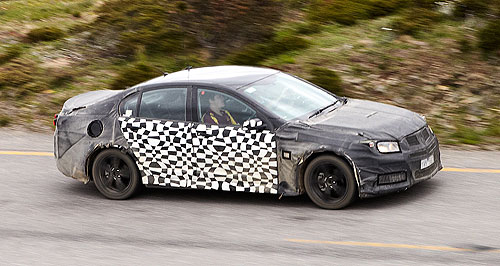News - HoldenHolden exits engineering tooBrain drain: Many automotive engineers axed by Holden will have no alternative but to seek work in Asia’s booming car industry. At least 400 Holden engineers to go as GM slams door on local vehicle development12 Dec 2013 By RON HAMMERTON and TERRY MARTIN GENERAL Motors’ decision to axe most of its Holden engineers by the end of 2017 along with its manufacturing operations spells the death knell for Holden’s global vehicle engineering role in Australia. Holden chairman and managing director Mike Devereux said today that although its engineering centre and proving ground will close, the company will look to use outside firms to tweak the suspension of its fully imported cars for Australian conditions. “When we look at tuning vehicles to the road conditions, that can also be done in other engineering centres,” he told ABC radio. “So to the extent that we retain that engineering centre (now) and wind it down over the next three to four years, we will also retain some amount of local tuning for the tastes of Australian consumers and to make sure that, no matter what, we continue to give Australian consumers cars that are ‘Holdens’.” Of the engineers to remain, most are likely to be assigned to supporting the Melbourne-based design studio that will continue working on global projects. GM has not spelled out exactly how many engineers will be made redundant, saying only it will “significantly reduce” Holden’s engineering operations. However, GoAuto understands that between the manufacturing engineers at the Elizabeth plant in South Australia and the Port Melbourne engine plant – both of which are closing – and the product development engineering team in Victoria, Holden currently has about 500 engineers. That is likely to be cut by at least 400, leaving between 50 and 100 engineers on the payroll. Society of Automotive Engineers Australia executive director Natalie Roberts – herself a former engine calibration engineer for Holden – told GoAuto that many of these engineers would struggle to find suitable employment in Australia. She said she already knew of several engineers who had left Australia to take up positions in Asia where car-makers were seeking to expand their car development operations. “We keep hearing about this transition to new industries in Australia, but where are they, what are they?” she said. Ms Roberts said successive government had chopped and changed policy in Australia, leading to uncertainty among car-makers about the long-term viability of engineering products here. “A new car platform takes 14 years, from its design and engineering and a 10-year model life, so manufacturers need policy certainty,” she said. Ms Roberts said the fallout from the Holden decision would also cost engineering jobs at automotive suppliers that develop products for local manufacturers. The union representing engineers, Professional Engineers Australia (PEA), said Holden’s decision to shut its manufacturing and engineering operations would cost some of “the best jobs in Australia”. PEA CEO Chris Walton said it was critical to Australia’s future to maintain a robust, diverse economy for the long term, “yet we now face the end of value-added manufacturing in Australia”. He said urgent action was needed to ensure that there was not a brain drain of highly skilled engineers from Australia. “The automotive sector – at the apex of the manufacturing sector – drives innovation, research and development and high-skill jobs,” he said. “Without those jobs, highly skilled engineers and technicians will have no choice but to go overseas." Holden’s decision to axe its engineering operation will leave Ford Australia as the only Australian manufacturer with the capability for a ground-up development of new global vehicle architectures. Ford Australia has carved out a significant global role in both design and engineering at its Victorian operations for products such as the Ranger ute and upcoming Everest SUV, with small cars for China also on the go. But even this capability is under pressure, with Ford Australia president Bob Graziano going before the Productivity Commission to call for continued government assistance for such operations. Toyota Australia has a small engineering and design capability in Melbourne, working on projects such as chassis development for the next-generation HiLux and design for the new HiLux-based Toyota Fortuna SUV. Until recently, Holden was the “home room” for the company’s global Zeta rear-drive vehicle architecture that underpins the Commodore, Caprice and their United States export offshoots, the Chevrolet SS and Caprice PPV police car, as well as the Canadian-built Camaro. The Zeta program has been axed in Australia, and the decision to cut the engineering capability – announced in yesterday’s media release from Detroit – signals an end to Australian responsibility for global platforms. The decision to shut the Lang Lang proving ground will mean the closure of the most advanced vehicle development facility in Australia. The proving ground not only has a maze of different sorts of roads for vehicle chassis testing and durability trials but also international-quality testing labs for things such as crash safety, emissions, noise abatement, hot and cold extreme testing and engine calibration. To build that facility from the ground up would cost millions.  Read more11th of December 2013  Holden quits: Union boss blasts AbbottFederal government has 50,000 redundancies on its hands, says union11th of December 2013  Holden quits: We will survive, dealer reassuresDealer says the only cars he makes money on are the ones built here11th of December 2013  Holden quits: Parts makers reel from decisionParts makers shocked, saddened by GM decision to cease manufacturing11th of December 2013  Holden quits: Car-maker's fate decided yesterdayGM leadership team pulls plug on Holden’s future in late-afternoon call11th of December 2013  Holden quits: Toyota considers standalone futureCar-making rival’s decision places “unprecedented pressure” on Toyota in Australia11th of December 2013  Breaking news: Holden calls it quits in AustraliaCar-making business to go as Holden moves to full importer by late 201710th of December 2013  GM has made no decision: DevereuxNo decision made on Holden manufacturing future, says MD Mike Devereux10th of December 2013  US government sells last GM sharesFinal General Motors shares sold by US government following 2009 bail-out9th of December 2013  $300m will save car-makers: CarrShadow industry minister puts $300m-a-year price on saving auto industry |
Click to shareHolden articlesResearch Holden Motor industry news |
















Facebook Twitter Instagram